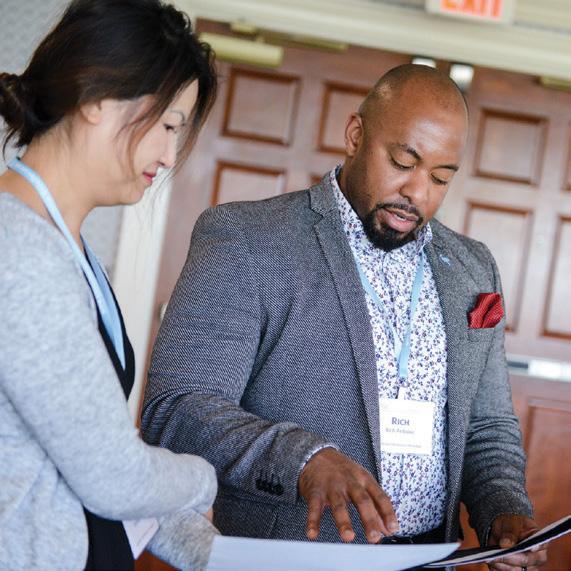
36 minute read
Grow Multicultural Leaders With Coaching
Coaching, G r o w M u l t i c u l t u r a l
L e a d e r s W i t h
Advertisement

Not Just Business English

BY NADIA NASSIF
As workforces continue to grow more diverse, human resources and learning and development teams have embraced language training programs, such as Business English and ESL, for multicultural employees. By strengthening communications skills and building a “same language” framework for the workforce, these initiatives not only foster individual development, they enhance collaboration and productivity and contribute to cultural cohesion.
Despite these efforts, however, companies often continue to experience excess attrition in their multicultural workforce as these employees seek better opportunities to enhance their skills, climb the career ladder and take on higher levels of leadership.
Employee turnover and replacement are costly. According to the Society for Human Resource Management’s 2016 “Human Capital Benchmarking Report,” the average cost-per-hire is $4,129, while the average time it takes to fill a given position is 42 days. Add to that a strong economy and low unemployment rate, and recruitment and retention have become harder than ever. To remain competitive now and into the future, organizations must attract and retain talented multicultural workers.
Consider the numbers: According to the Bureau of Labor Statistics, nearly 1 in 5 workers in the U.S. is foreign-born (17 percent), and this number is growing. Almost one-third of these workers are in professional/ management positions — highly sought after by recruiters, they provide significant value to their organizations. But even organizations practicing diversity-based recruiting don’t always succeed in creating an inclusive, welcoming culture that encourages retention.
“Diverse hiring practices don’t always translate into a more diverse workplace or improved employee retention,” wrote Zoe Mackey in her 2019 article, “Here’s How Workplace Diversity Impacts Employee Retention.” “Lack of alignment among goals is disillusioning to diverse employees, who come to regret their career decisions (after such a promising start during hiring) and end up leaving for better opportunities.”
If employees — particularly those from different cultural backgrounds — feel they are not adequately invested in or supported in their skills development, it may be because they aren’t. In a recent survey conducted by Wiley Education Services and Future Workplace,“Closing the Skills Gap 2019,” fewer than half of the 600 surveyed HR leaders reported spending $500 or more to upskill individual employees. And looking ahead, such minimal investment could prove even more troubling as demand for higher-order skills increases. A November 2019 article in ATD’s TD Magazine, “Future-Ready or Not?” noted, “McKinsey predicts that demand for social and emotional skills will grow by 26 percent by 2030 across all industries in the United States. Some of these skills (such as empathy) are innate, but individuals can hone or learn others (like advanced communication).”
By conducting an accurate assessment of development needs, especially for their diverse and foreign-born population, and ensuring that the right strategies and tools are in place to promote career growth, organizations can tackle the skills and retention challenge head-on. HR and L&D leaders will likely begin by considering what role communications coaching and language learning programs can play in helping to meet the development need. But first they should be clear — and aligned — on goals, determine what resources are available, assess the pros and cons of each option, and define the desired result.

A Higher Order of Challenges
There’s no question that meeting the basic language needs of multicultural employees is critical. Lacking confidence in their ability to communicate in English on par with colleagues — or at a level commensurate with their professional skills — some may become demotivated and start to withdraw. For these individuals who are dealing with needs that are primarily language-driven (accent, idiomatic language, vocabulary and grammar), ongoing, intensive ESL instruction, either in person or online, may make the most sense. Toward that end, group classes or an e-learning solution to develop language skills and literacy should be considered.
By contrast, many multicultural professionals will have had extensive language instruction throughout their education; their communications challenges may be based more in the norms and preferences of their cultural backgrounds. As they advance in their careers and seek roles requiring leadership and higher-level communications skills, their development needs will likely not be met by ESL or Business English programs. Instead, individual coaching support, geared toward developing leadership-level skills within an all-English speaking or American business context, is the best way to address typical concerns, such as: • The hesitancy of some multicultural employees when it comes to letting their voices be heard. • The difficulty of integrating across multicultural teams in the face of negative cultural stereotypes. • The potential for misinterpretation or difficulty in understanding across languages and cultures. • Uncertainty around professional etiquette norms. • Conflicting working styles across diverse teams.
Sameer’s Story
The following scenario is based on an actual coaching engagement. Sameer, a high-performing consulting professional originally from India, recently transferred to his firm’s Atlanta office and has been asked by his manager to take on a role that would include business development. Sameer is highly educated, with strong technical and analytical skills, and has spent enough time learning American idioms to figure out what “step up to the plate” means. But he is now faced with new assignments that require strong culturally informed communications capabilities, more nuanced and more complicated to master than language skills.
From networking and small talk to relationshipbuilding and marketing calls, Sameer will need to gain fluency in business communications in order to succeed with clients. He’ll also have to figure out where his approach to communications may be at odds with that of the dominant culture, whether clients or colleagues, and to master appropriate, politically astute interaction.
A needs assessment of Sameer may include recognizing the influence of his normative values on his communications style; for example, what social psychologist and management professor Geert Hofstede calls the “power distance” factor, in which “the less powerful members of organizations and institutions (like the family) accept and expect that power is distributed unequally.” Sameer feels he has a firm handle on how to interact with senior management, but they find him overly formal and sometimes too deferential, hampering his ability to build partnerships with firm leaders. And in his supervisory role, in which he provides direction to more junior employees (the “less powerful”), he displays a hierarchical mode of behavior that can come across as overly authoritative and even condescending, according to recent performance review feedback.
Addressing these needs will far exceed the scope of most ESL or Business English programs and merits an individualized approach commensurate with the level and demands of Sameer’s role. Careful selection of the right approach doesn’t just ensure alignment of the need and offering — it signals a strategic investment in an emerging leader and in important corporate goals such as succession planning and the future growth of the firm. Understanding Multicultural Barriers
The potential challenges to advancement and professional success facing Sameer confront many up-and-coming multicultural professionals. There are a number of typical barriers.
One common barrier is understanding the corporate culture and how one’s culturally informed preferences and norms may differ in terms of both verbal and nonverbal communications. If these differences are not surfaced and addressed thoughtfully, communication breakdowns can result, eroding relationships with senior management, mentors, colleagues and direct reports. The multicultural employee gets demotivated, the environment feels less inclusive and, as this dynamic builds over time, the employee no longer feels they fit and may move on. As noted in a Hult International Business School blog, “13 Benefits and Challenges of Cultural Diversity in the Workplace,” “Colleagues from different cultures can also bring with them different workplace attitudes, values, behaviors and etiquette. Nonverbal communication is a delicate and nuanced part of cultural interaction that can lead to misunderstandings or even offense between team members from different countries.”
Another barrier is leveling the playing field and becoming competitive in a client-facing or senior role by developing a strong set of relationship-building skills, demonstrated by persuasive writing, influencing, vocal dexterity (especially when communicating remotely) and emotionally intelligent responsiveness, critical in high-stakes situations.
Imagine, for example, a high-performing multicultural manager unsure of whether it’s appropriate to speak up in a client meeting, or of how to interrupt respectfully to make a point. A coaching client recently shared his conundrum: “I don’t know which is worse: Do I try to chime in and interrupt and come off as too aggressive? Or do I stay quiet, knowing it’s inappropriate at my level not to contribute?” Lacking confidence in his ability to read the room and be seen as credible, he retreats, missing an important opportunity to benefit himself and his company. “The bottom line takes a hit when employees stop participating in group settings,” wrote Tsedal Neeley in “Global Business Speaks English,” published in 2012 in Harvard Business Review. “Once participation ebbs, processes fall apart. Companies miss out on new ideas that might have been generated in meetings.”
Another common hurdle is deepening one’s leadership presence by successfully mentoring and managing in ways that inspire and uplift individuals, teams and, ultimately, the overall workplace. Exploring Solutions
In Sameer’s case, the goals are retention, promotion and optimizing the employee experience for a multicultural employee, making coaching the right vehicle. If, however, the training goal is tied primarily to reducing Nearly 1 in 5 workers in the U.S. is foreignborn, and this number is growing.
Future-proof your workforce

Stand out in a competitive talent market by offering employees educational benefit programs that improve retention and engagement while driving business performance. Organizations that leverage education as a strategy see: • reduced turnover costs • enhanced employability skills • improved productivity • new talent pipelines We deliver meaningful programs aligned to the needs of all your employees. Learn how Pearson improves business performance by building a workforce that’s more skilled, competitive, engaged, and prepared for the future of work. pearsonaccelerated.com
inefficiency, improving quality of work product and reducing communication bottlenecks, the right choice would likely be a language-based solution, at least as a “Phase 1,” almost certainly followed down the road by a more in-depth “Phase 2.” And, as is often the case, the most successful coaching outcomes stem from involvement of the coachee’s mentors and managers. L&D can play a key role in making sure that management is on board and is given the tools to be more culturally aware, including an inclusive vocabulary with which to discuss and evaluate the skills, communications behavior and performance of multicultural employees.
Ensuring the right solution to help multicultural professionals meet advancement challenges starts with an understanding of the desired behavioral changes, an in-depth assessment of need and alignment of the approach with corporate L&D goals. Drawing on Kirkpatrick’s four levels of training evaluation, an L&D manager might explore a differentiated approach combining an ESL/Business English program and tailored one-on-one coaching (as described in “Meeting the Communications Need 1” below), depending on the mix of need and behavior change (Kirkpatrick’s level 3, behavior) identified, as well as the corporate goals and desired outcomes (level 4, results). Meeting the Communications Need 1: Writing Skills
When focusing not only on multicultural employee development but on achieving critical D&I goals such as enhanced recruitment, reduced attrition and increased promotions, L&D teams can take a number of learning pathways. Here’s an example that achieved a firm’s dual goals: to better leverage senior staff by reducing their involvement in lower-level delegable work, and to boost advancement and promotion, especially at certain career levels.
A pharmaceutical company’s training team had determined that a high percentage of senior managers’ overtime hours were spent editing and quality-controlling the written work product of ESL employees. These employees, whose efforts were often eclipsed by those of colleagues proficient in written English, were promoted less frequently and sensed that the skills development key to their advancement was out of reach.
The company introduced a group writing program designed to enhance writing skills and enable participants to gain independence in report writing. The initiative incorporated individual sessions on effective writing methods, addressed grammar and syntax needs, and provided coaching support for individuals as well as group work. In a 12-month follow-up assessment of impact, the company determined that two weeks of FTE-equivalent hours per manager had been saved, in terms of reduced or eliminated re-work. In addition, several program participants went on to key roles the same year, outcomes that achieved behavior change based in functional skills acquisition and the larger corporate goal. Meeting the Communications Need 2: Leadership Skills
In a case example highlighting a different need and approach, the HR and L&D teams of a Big 4 consulting firm determined, based on performance review feedback and exit interview data, that turnover of multicultural employees at managerial levels was largely due to lack of leadership communications skills, including supervisory abilities, client interaction skills and writing proficiency. This input prompted L&D leaders to introduce individualized cultural coaching programs focused on helping emerging managers to mentor and supervise junior employees and to communicate professionally in presentations and business writing. Two to three years into the initiative, turnover rates among multicultural program participants were tracked against same-level multicultural employees who did not receive coaching. All program participants were promoted on or before schedule, while the majority of nonparticipating peers showed no advancement or, even worse, attrition.
In this case, coaches equipped with the requisite skills to support multicultural leaders proved best-suited to ensure attainment of the higher-order skills associated with leadership and senior professional roles that rely on both intellectual capital and emotional IQ. The ROI of coaching speaks for itself: Training contributes directly to employee commitment, productivity and progress — and is therefore an important driver in reducing the high cost of turnover. Faster, Better
Arie de Geus, former CEO of Shell Oil Co., declared decades ago in Harvard Business Review article “Planning as Learning” that “the only competitive advantage the company of the future will have is its managers’ ability to learn faster than their competitors.” I would add that it is not only the ability to learn faster, but the ability to learn better that will truly distinguish successful organizations going forward. CLO Careful selection of the right approach signals a strategic investment in an emerging leader. Nadia Nassif is founder and CEO of Springboards Consulting.


ABOUT UNC EXECUTIVE DEVELOPMENT
An internationally recognized leader in the field of executive education, UNC Executive Development takes great pride in designing and delivering innovative programs that drive impact for both individuals and their organizations.
We conduct 200 programs per year, serving 5,000 executives from a network of industries and global organizations, including Fortune 500 companies. We collaborate with organizations to develop customized solutions to address specific business needs and also offer a portfolio of skill-based, in-person and online Programs for Individuals. As a part of the UNC Kenan-Flagler Business School, we draw upon the School’s 100-year reputation and faculty expertise, grounded in a past of integrity and proven excellence. UNC Executive Development is ranked No. 2 in the U.S. and No. 9 in the world according to the 2019 Financial Times Executive Education survey, a testament to our readiness and capabilities in supporting the Future of Work.
Globally (3rd year in a row) VALUE FOR MONEY # 1
# 3 TEACHING METHODS in the US FACULTY in the US # 2 AIMS ACHIEVED in the US # 2
# 2 IN THE U.S. for Education Programs Custom Executive
No. 9 Globally for Custom Programs
Source: 2019 Financial Times Ranking for Custom Programs
HOW WE PARTNER TO ACHIEVE RESULTS
We believe in building a strong and collaborative relationship with you to co-create innovative learning solutions based on the nuances of your business environments, target populations, and strategic imperatives, resulting in real business impact.
INQUIRY We ask questions to learn
INNOVATION We are innovative in our approach
IMPACT We focus on the desired results
The Golden Arches Go Digital
BY SARAH FISTER GALE
There’s a good chance your first job was at a
McDonald’s. The $21 billion restaurant franchise is the second-largest private employer in the world, employing 1.7 million people in more than 37,000 restaurants worldwide, according to various reports from 2018.
That means hiring and retaining workers is a constant challenge. The average turnover rate for fast food restaurants is now 150 percent — the highest it’s been since 1995, according to a report from MIT.
It’s not unexpected given the demographic of the average fast food employee, said Rob Lauber, senior vice president and chief learning officer of McDonald’s Corp., which is headquartered in Chicago. “For many, it is their first job or a transitional job while they go to school,” he said.
While McDonald’s recognizes that most employees won’t spend their careers with the company, they would like them to stick around for a few years at least. But in a low-unemployment economy, where even hourly employees have a lot of options, the company has had to get more innovative about how it attracts and retains staff. And they are using education as a way to do it.
Under the Archways
Five years ago, McDonald’s launched Archways to Opportunity, a comprehensive education strategy with multiple programs giving employees access to free general education options, as well as up to $3,000 per year in college tuition assistance after 90 days of employment. Employees and their immediate families can use the program to improve their English skills, earn a high school diploma, or help pay for a two- or four-year college degree.
One of the most unique aspects of Archways is that it doesn’t dictate what employees need to study or where they can study, said Marie Cini, president of the Council for Adult and Experiential Learning, a nonprofit adult education organization in Chicago that has partnered with McDonald’s through the Archways program. “They can get whatever degree they want.”
SNAPSHOT McDonald’s new Archways to Careers app gives employees access to live education advisers to help them plan for the future.
While some employees use these training programs to move up in the organization, others use them to launch a career in another field. And that’s OK, Lauber said. Even if they are using the training to move to another job or field, they are more likely to stick around while they complete their education. It’s a powerful tool for attraction and retention. “Archways helps answer the question of ‘Why should I work at McDonald’s,’ and ‘Where will this job take me?’ ” Lauber said. “It gives people a reason to want to work here.”
Archways Goes Digital
In January, McDonald’s added a new element to its Archways arsenal. The Archways to Careers app, which anyone can download, offers self-paced content and real-time career advising to help employees map out the next steps in their professional journey.
Lauber sees the app as the entry point for employees to take greater advantage of the entire Archways program. “It creates stickiness and makes the program more accessible,” he said.
The app starts with a personal inventory survey that helps users identify their skills and interests as a way to think about what kind of career they might like. Then it provides information in easyto-digest chunks that will help them think about their next steps. The content answers questions like, “How can I get a high school diploma online?” “How do I explore my education and career opportunities?” and “How can I get money to pay for college courses?”
“If you’ve never had someone to have these conversations with, they can be tough questions to answer,” Cini said.
The app provides links to colleges that offer discounted tuition on top of McDonald’s tuition
Deliver exceptional organizational performance with pioneering e-learning technology and creative, engaging content


Online learning platforms, content and analytics Low total cost of ownership solutions • • Learning Technologies Company of the Year 2018 Award-winning, multi-tier customer support
Innovation. Passion. Learning. We’re one of the only truly full-service e-learning providers, offering a range of content, platforms and analytic solutions to over 750 organizations and more than 2.5 million learners in 21 countries. With the largest and most flexible catalogue of content on the market, we deliver a highly customized learning experience, combining expertise in personalized learning, gamification, AI-driven performance and learning analytics. Visit Learningpool.com or call (857) 284-1420
assistance, as well as advice on how they can translate the training they have already received at McDonald’s into college credit.
Users can also access live advisers via the app to help them dig deeper into what career path they might want to follow and how they can get there with the help of Archways. “We help them consider all of their educational options,” said Kai Drekmeier, president of Inside Track, an educational management firm based in Portland that provides these student coaching services.
The advisers do more than just walk users through the college application process. They help them figure out how to make the most effective use of the program’s resources so they can be “smart consumers of education,” Drekmeier said. That includes thinking through how they will use the degree they are pursuing, and what it will take for them to be successful. “We want them to know that this is a real-time commitment, and they have to be sure they are going to show up and do the work. Otherwise they won’t get the benefit.”
The advisers also help them plan strategies for success, including how to talk with their managers about building a schedule around classes, how to make time for studying, and how to juggle child care and other responsibilities. Users are encouraged to reach back out to the advisers whenever they encounter a challenge or feel frustrated with the process. “We help them identify the problems they are facing and talk through the solutions so they can solve these problems on their own,” Drekmeier said. “Giving them that confidence makes a big difference to their future success.”
Gateway to the Future
Cini believes the combination of self-paced content and live advisers will be especially appealing to younger employees who are accustomed to finding answers on their own before reaching out to a person for help. Whether it’s online banking or ordering a pizza, millennials and Generation Z don’t expect human encounters. “They might be afraid to just call an adviser,” she said. The app may give them the answers they need, or it may give them the confidence to call an adviser to get more information. “It provides a gateway to career coaching.”
The app is still new, but McDonald’s is confident that it will further enhance the value of the Archways educational program and help the company attract and retain hourly workers for longer.
To date, Archways has provided tuition assistance to more than 35,000 employees, awarded $90 million in high school and college tuition assistance and celebrated more than 750 graduates in the Career Online High School Program. Lauber estimates that 60 percent of franchises have employees taking advantage of the program. And when employees achieve education milestones, franchise owners and corporate make a point of celebrating their successes with ceremonies, news articles and even profiles on the app. “We make a big deal out of it,” Lauber said.
“We want people to be able to pursue their passions. That’s our learning culture.” — Rob Lauber, SVP and chief learning officer, McDonald’s Corp.
That publicity and public acknowledgment reinforce the value these employees bring to the company and help spread the word to other current and future staff that these resources are available to them. “We want people to be able to pursue their passions. That’s our learning culture,” Lauber said.
The company is planning to conduct a study to measure the impact of Archways on attraction and retention, and Lauber is confident that it will prove the investments are paying off. “When people see that they can gain skills that will take them to myriad other industries, it gives them a reason to stay.”
For other organizations considering similar programs, Cini suggested they begin by looking at their existing tuition assistance offerings and how they are deployed and promoted. She noted that many companies treat tuition assistance as just another employee benefit. “Instead, they should view it as a strategic investment in their human capital,” she said. When companies switch their mindset, they will start to think differently about how they can leverage these investments to attract and retain talent.
Then make sure you really understand the needs of the target audience, Lauber added: “You have to meet them where they are and create something that will be impactful for each individual as they think about their future.” CLO

Seeking Measurement Champions
What you are measuring, and how you are measuring it, will be key to achieving true workforce transformation in the future.
BY ASHLEY ST. JOHN
Learning measurement isn’t the sexiest of topics, but it’s absolutely an important one. Especially when learning leaders are held accountable for tying learning and development efforts back to solid business outcomes — essential to getting executive buy-in and, ideally and critically, executive championship.
Eighty-three percent of surveyed L&D pros said that executive buy-in is not a challenge. That’s according to LinkedIn Learning’s “2020 Workplace Learning Report.” However, as the report accurately states, “It’s one thing to buy into a strategy and quite another to champion it across the organization.” And according to the same report, only 27 percent of L&D leaders said their CEOs are active champions of learning.
This is where measurement can play an important role. But currently, CLOs express dissatisfaction with the extent of learning measurement in their organization.
According to data from the Chief Learning Officer Business Intelligence Board’s “2019 Learning State of the Industry” report, less than half — 42 percent — of surveyed CLOs are satisfied with their current measurement efforts. However, 77 percent said they plan to increase their learning analytics capability over the next two years.
The Chief Learning Officer Business Intelligence Board is a group of 1,500 professionals in the learning and development industry who have agreed to be surveyed by the Human Capital Media Research and Advisory Group, the research and advisory arm of Chief Learning Officer magazine. This survey was conducted in early 2019.
According to the report, 84 percent of respondents measure internal learning customers’ satisfaction, 61 percent measure external customers’ satisfaction, and 59 percent say their measurement and metrics are fully aligned with learning strategy. Only 43 percent externally benchmark their measurement and metrics practices (Figure 1).
When it comes to what is being measured, it seems that current measurement efforts are focusing more on the short-term and less on the bigger picture. Seventy-two percent of CLOs are currently measuring employee response to training and 60 percent are measuring employee engagement, but less are measuring the actual increase in employee knowledge or skills — 58 percent — and even fewer are measuring overall business performance and retention, both at 46 percent. A startlingly low 20 percent are measuring formal ROI for learning (Figure 2).
It’s encouraging that learning buy-in by executives is perceived as quite high among L&D leaders. But to truly take these efforts to the next level and deliver the workforce transformation that we need going into the future, they must be championed by executives across entire organizations. And to gain that championship, focus on the long-term is key.
It should also be noted that only 12 percent of respondents to the survey said their organization is enabled by technology to collect, aggregate and integrate big data (Figure 3). This is poised to be a crucial differentiator as we move into the new decade.
To read more about the six measurement areas that are poised to transform our profession in the coming decade, see page 40. There’s a lot on the horizon for measurement and analytics, especially as technological capabilities continue to grow. And successfully taking advantage of these capabilities could provide the L&D championship every organization needs. CLO
FIGURE 1: EVALUATE THE FOLLOWING STATEMENTS IN RELATION TO YOUR COMPANY
Agree Disagree
We measure internal learning customers’ satisfaction.
16% 84%
We measure external learning customers’ satisfaction.
61%
39%
Measurement and metrics are fully aligned with learning strategy.
59%
41%
We externally benchmark our measurement and practices.
43%
57%
FIGURE 3: IS YOUR LEARNING FUNCTION ENABLED BY TECHNOLOGY TO COLLECT, AGGREGATE, INTEGRATE AND ANALYZE BIG DATA
42% 46%
12% FIGURE 2: INDICATE YOUR PLANS TO MEASURE THE IMPACT LEARNING HAS ON EACH OF THE FOLLOWING
Already do it Plan to within 12 months
Plan to — no time frame Plan to within 12-24 months
No plans
Employee response to training
13% 5% Employee engagement Increase in employee knowledge or skills Overall customer satisfaction Overall business performance Employee retention Product or service quality Other organizational KPIs Employee productivity Sales Net promoter score Formal ROI on learning Employee chargeability/billability 5% 5% 60% 21% 8% 6% 6% 58% 24% 8% 6% 4% 54% 15% 9% 6% 16% 46% 18% 13% 9% 14% 46% 21% 10% 11% 13% 40% 19% 11% 10% 21% 39% 19% 12% 10% 20% 39% 24% 12% 12% 14% 35% 13% 8% 7% 37% 33% 11% 7% 10% 39% 20% 27% 20% 11% 23% 19% 15% 9% 9% 48%
points of view. It can also be greatly facilitated by peers. At the same time, having remote teams makes it easy to overlook change advocates — positive “disruptors” who see the big picture and are comfortable challenging the current state — who could be accelerating the change process. Social media has proven the power of networks and smart leaders need to be prepared to use those networks to their advantage in driving change.
Finally, teach leaders to deputize, not just delegate. Long ago, management theory recognized that simply distributing work efficiently left productivity on the table. Employees could contribute even more when managers delegated effectively. But to support transformational change at the fastest possible pace, even that isn’t enough anymore. The time has come for leaders to work toward deputizing their best people. Like a sheriff in the Wild West of 150 years ago, deputizing confers true power. It means handing over real responsibility and the authority to make decisions.
This kind of empowerment drives engagement and speeds up decision-making, putting it in the hands of the people closest to work involved. It helps build confidence as employees learn by doing and from their own mistakes. Deputizing fast-tracks professional growth, which has become among the most significant factors in the retention of younger workers. As their confidence, experience and skills grow through meaningful leadership opportunities, it also feeds an organization’s succession planning pipeline.
The New Decade Brings New Requirements
If this decade requires something different of companies to survive — and it seems the consensus is that it will — it certainly requires something different of leadership teams. Attitudes toward change can be shaped, skills can be developed and behaviors can be changed, but the race is on. It’s time to stop hiding behind the notion that change is hard because, while it may be true, it won’t help organizations navigate the increasingly VUCA world.
The coming years promise to swiftly separate the winners from the losers — those who see change as an obstacle from those who see it as an opportunity. How well are your organization’s leaders prepared with the right mindset, skills and behaviors to guide transformational change in the new decade? CLO
Mark Marone is the director of research and thought leadership for Dale Carnegie & Associates.
The Business Acumen Workshop Teach your team to think like an entrepreneur but operate like a CEO.

The Business Acumen Institute focuses on one thing, and one thing only: to make business people better so they can collaborate, solve problems, execute on strategy, and deliver results to their firm.
important, we would all agree that the profession needs to move beyond scorecards.
The next level up is to use measures to monitor. Often a measure has been performing in an acceptable range (like a level 1 score of 90 percent favorable or better) and we just want to ensure that it stays in the acceptable range. This is called monitoring and the resulting dashboard is often color-coded, showing in red the measures that are out of compliance. Monitoring requires the setting of thresholds, so it takes more work than simply reporting results.
The third level encompasses traditional program evaluation where the five levels are used to determine if the program was effective. Another activity at this level of maturity is the higher-level analytics discussed earlier. In this case, statistics like correlation and regression are used to explore the relationships between measures (like amount of learning and employee engagement). When a good statistical relationship is found, that relationship can be used to predict the value of one measure (like engagement or retention) based on the value of another measure (like amount or type of learning). This is predictive analytics and an exciting new area for L&D and HR in general. Like determining isolated impact for level 4 in a program evaluation, predictive analytics requires a much higher level of analysis than that required for monitoring.
There is, however, a higher-level purpose for measurement that has even greater potential for L&D than predictive analytics. This is the active management of programs and initiatives to deliver planned values. This requires significant analysis to create a plan for the targeted measure and significant analysis during the year (or life of the program) to understand why the measure is not on plan and what steps can be taken to get back on plan before the year ends. This is the hard work of management. Figure 2 (page 44) lays out the different aspects of each maturity level, including the analysis and reporting used.
The most complex application of measuring to manage can be found in the planning and execution of a program in support of an important organizational goal, like increasing sales or improving quality. In this case, L&D professionals must work closely with the goal owner (like the head of sales) to confirm that learning has a role to play in helping achieve the goal, agree on the program and the planned impact of learning on the organization goal (like 2 percent higher sales due to learning), and agree on the planned values for all the key efficiency and effectiveness measures required to deliver that impact (like number of participants, timing and application rate). Once the year is underway, it is unlikely everything will go according to plan, so both parties will have to actively manage the key measures to come as close to plan as possible.
In my opinion, data-driven management represents the highest level of maturity in an organization and the greatest opportunity for L&D in the measurement and reporting space. More than any of the other exciting trends discussed so far, this has the potential to deliver the greatest incremental impact for our efforts and to make us the valued, strategic business partners we aspire to become.
What Lies Ahead
We are a young profession with a lot of work ahead of us, which means that each of us can play a role in shaping our future. So experiment, question and build on the work of others to advance our thinking and increase the impact we can have on individuals and organizations. CLO
David Vance is the executive director for the Center for Talent Reporting.
ADVERTISING SALES
Daniella Weinberg Eastern Sales Director 917-627-1125 dweinberg@ChiefLearningOfficer.com
Ana Dirksen Western Sales Director 312-847-5729 adirksen@ChiefLearningOfficer.com
Kevin M. Fields Vice President, Business Development for Events 312-967-3565 kfields@ChiefLearningOfficer.com
Melanie Lee Business Administration Manager mlee@ChiefLearningOfficer.com
Advertising: For advertising information, write to sales@ChiefLearningOfficer.com.
Back Issues: For all requests, including bulk issue orders, visit our website at ChiefLearningOfficer.com/products or email hcmalerts@e-circ.net.
Editorial: To submit an article for publication, go to ChiefLearningOfficer.com/submission-guidelines. Letters to the editor may be sent to editor@ChiefLearningOfficer.com.
Permissions and Article Reprints: No part of Chief Learning Officer can be reproduced without written permission. All permissions to republish or distribute content from Chief Learning Officer can be obtained through PARS International. For single article reprints in quantities of 250 and above and e-prints for web posting, please contact PARS International at MediaTecReprints@parsintl.com.
Subscription Services: All orders, inquiries and address changes should be addressed to Computer Fulfillment PO Box 8712 Lowell, MA 01853 or call customer service at 800-422-2681 or 978-671-0446 or email hcmalerts@e-circ.net.
3 Trends Shaping Future Leaders
Preparing for leadership in the years ahead • BY JACOB MORGAN
Jacob Morgan is an author, TED and keynote speaker, futurist and creator of FutureofWorkUniversity.com.
Leadership doesn’t happen in a vacuum. What goes on in the outside world has a huge impact on leaders. One of the most important characteristics of future leaders will be their ability to adapt with changing trends. I believe there are three major trends shaping the future of leadership and the implications for future leaders.
First, there’s artificial intelligence and technology. As part of the research for my new book, “The Future Leader,” I interviewed more than 140 CEOs around the world and asked what they viewed as the most impactful trends for future leaders. By far, the most common answer I received was AI and technology.
AI is continually evolving and has tremendous power to disrupt and change the business world. We’re already seeing some of its impact, and that will only continue to grow as AI becomes more powerful and mainstream. In fact, more than 60 percent of CEOs I surveyed believe or strongly believe that AI will have a larger impact than the internet.
Technology opens the doors for companies to increase their productivity, become more sustainable and better serve their customers. But it also comes with uncertainty. Despite some common fears, the vast majority of CEOs I spoke with were incredibly optimistic. The positive benefits far outweigh any potential downfalls. Leaders need to find ways to add technologies that add value to employees instead of replacing them. AI has the power to help leaders make faster decisions and quickly and accurately analyze data. Using AI at work will force future leaders to use more soft skills that are uniquely human.
The next important change I’ll address is the new talent landscape. According to one CEO I interviewed, the competition for talent is often fiercer than the competition for customers. Changing skills and generations mean that the talent landscape is evolving and bringing a shortage of skilled workers. One PwC survey found that the availability of key skills is the third biggest threat facing organizations today. As older generations retire, younger, less experienced employees are put in many positions. Technology is changing so quickly that many employees can’t keep up or don’t have the necessary skills. Employees are responsible for their own career development, but leaders and organizations also need to pay attention to developing and reskilling their workers and providing growth opportunities. Leaders also must help employees understand how their jobs are changing so they can take control of their own career development.
As younger employees enter the workforce, there is also a greater emphasis being placed on diversity and inclusion. Companies need to be welcoming of everyone, regardless of their background. Successful companies celebrate diversity and welcome people with all points of view. Future leaders should strive to develop diverse teams and build an inclusive culture where everyone belongs.
Finally, there’s the importance placed on purpose and meaning. It used to be that in order to attract and retain the best talent, companies simply needed to pay their employees more. That’s no longer the case. Today’s employees, especially millennials and younger generations, want to work for organizations that offer purpose and meaning. Employees given meaningful work are more engaged, stay with the company longer and take fewer sick days. As the line between work life and personal life gets blurrier, it’s important to create an environment that delivers both purpose and meaning to employees.
A sense of purpose is a driving force for an organization. It’s what the company stands for and what it contributes to the world. A sense of meaning tends to be more individual and signifies a personal sense of accomplishment and importance. Employees don’t want to do their jobs just to get a paycheck; they want to feel like they are contributing to something bigger than themselves and making a positive difference.
Before leaders can help their people, they need to fully understand their own purpose and meaning. Future leaders need to get to know employees individually to find out what motivates them. Successful companies will make purpose and meaning a core part of their organizations, especially when attracting new talent, and use storytelling to help employees understand the impact of their work.
Future leaders face a fluctuating work and social landscape. To be prepared, they need to leverage change into positive action for their organizations. CLO
Develop Your Talent, Build an Agile Workforce

DRIVE BOTTOM LINE RESULTS ENSURE BUSINESS
SUSTAINABILITY IMPROVE EMPLOYEE
RETENTION
Empower your organization to attract, recruit, develop, and retain top talent to succeed in today’s highly competitive and talent-scarce market. SumTotal enables organizations around the globe to develop talent and drive productivity, performance, and improved business outcomes.
SumTotal offers the most configurable learning solution on the market, meeting the needs of the most complex learning challenges for enterprise organizations worldwide. Our solution enhances your processes making learning a competitive advantage for your company.
Learn more about SumTotal’s award-winning solution at sumtotalsystems.com
Corporate strategies CHANGE, Knowledge demands GROW, Empowered executives LEAD.











Be WHARTON READY. Learning solutions that transform people and organizations.
Wharton Executive Education offers results-driven learning solutions that drive measurable impact. We’ll partner with you in a fully collaborative experience to analyze your objectives, identify your challenges, and infl uence executive behavior for ongoing organizational success.





programs for Organizations
CUSTOM PROGRAMS
GROUP ENROLLMENT



